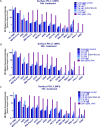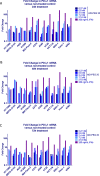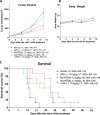PEGylated arginine deiminase can modulate tumor immune microenvironment by affecting immune checkpoint expression, decreasing regulatory T cell accumulation and inducing tumor T cell infiltration
- PMID: 28938609
- PMCID: PMC5601705
- DOI: 10.18632/oncotarget.19564
PEGylated arginine deiminase can modulate tumor immune microenvironment by affecting immune checkpoint expression, decreasing regulatory T cell accumulation and inducing tumor T cell infiltration
Abstract
PEGylated arginine deiminase (ADI-PEG 20) is being investigated in clinical studies in arginine auxotrophic cancers and is well-tolerated. The anti-tumor properties of ADI-PEG 20 have been extensively investigated - ADI-PEG 20 inhibits the growth of auxotrophic cancers in vitro and in vivo - however, its impact on immune cells is largely unknown. Here we report the potential impact of ADI-PEG 20 on the tumor immune microenvironment. ADI-PEG 20 induced immunosuppressive programmed death-ligand 1 expression on some cancer cells in vitro, but the magnitude of the increase was cell line dependent and in most relatively small. Using healthy donor human peripheral blood mononuclear cells (PBMCs) we discovered that when present during initiation of T cell activation (but not later on) ADI-PEG 20 can inhibit their differentiation after early activation stage manifested by the expression of CD69 marker. In vivo, ADI-PEG 20 induced tumor T-cell infiltration in a poorly immunogenic syngeneic mouse melanoma B16-F10 model and reduced its growth as a single agent or when combined with anti-PD-1 mAb. It was also effective by itself or in combination with anti-PD-L1 mAb in CT26 colon carcinoma syngeneic model.
Keywords: PD-L; TILs; Treg; arginine deiminase; immunomodulation.
Conflict of interest statement
CONFLICTS OF INTEREST All authors are employed by Polaris Pharmaceuticals and have options of Polaris Pharmaceuticals stock.
Figures










Similar articles
-
A novel combination therapy of arginine deiminase and an arginase inhibitor targeting arginine metabolism in the tumor and immune microenvironment.Am J Cancer Res. 2023 May 15;13(5):1952-1969. eCollection 2023. Am J Cancer Res. 2023. PMID: 37293150 Free PMC article.
-
Phase 1b study of pegylated arginine deiminase (ADI-PEG 20) plus Pembrolizumab in advanced solid cancers.Oncoimmunology. 2021 Jul 12;10(1):1943253. doi: 10.1080/2162402X.2021.1943253. eCollection 2021. Oncoimmunology. 2021. PMID: 34290906 Free PMC article. Clinical Trial.
-
Pegylated arginine deiminase (ADI-SS PEG20,000 mw) inhibits human melanomas and hepatocellular carcinomas in vitro and in vivo.Cancer Res. 2002 Oct 1;62(19):5443-50. Cancer Res. 2002. PMID: 12359751
-
Drug evaluation: ADI-PEG-20--a PEGylated arginine deiminase for arginine-auxotrophic cancers.Curr Opin Mol Ther. 2006 Jun;8(3):240-8. Curr Opin Mol Ther. 2006. PMID: 16774044 Review.
-
The role of arginine and the modified arginine deiminase enzyme ADI-PEG 20 in cancer therapy with special emphasis on Phase I/II clinical trials.Expert Opin Investig Drugs. 2014 Nov;23(11):1517-29. doi: 10.1517/13543784.2014.934808. Epub 2014 Jun 26. Expert Opin Investig Drugs. 2014. PMID: 24965808 Review.
Cited by
-
Innate and adaptive resistance mechanisms to arginine deprivation therapies in sarcoma and other cancers.Cancer Drug Resist. 2019 Sep 19;2(3):516-526. doi: 10.20517/cdr.2019.49. eCollection 2019. Cancer Drug Resist. 2019. PMID: 35582579 Free PMC article. Review.
-
A novel combination therapy of arginine deiminase and an arginase inhibitor targeting arginine metabolism in the tumor and immune microenvironment.Am J Cancer Res. 2023 May 15;13(5):1952-1969. eCollection 2023. Am J Cancer Res. 2023. PMID: 37293150 Free PMC article.
-
A Phase 1 study of ADI-PEG20 (pegargiminase) combined with cisplatin and pemetrexed in ASS1-negative metastatic uveal melanoma.Pigment Cell Melanoma Res. 2022 Jul;35(4):461-470. doi: 10.1111/pcmr.13042. Epub 2022 May 16. Pigment Cell Melanoma Res. 2022. PMID: 35466524 Free PMC article. Clinical Trial.
-
[Immune Checkpoints Mediate Tumor Immune Regulation through Metabolic Pathways].Zhongguo Fei Ai Za Zhi. 2025 Mar 20;28(3):213-220. doi: 10.3779/j.issn.1009-3419.2025.106.08. Zhongguo Fei Ai Za Zhi. 2025. PMID: 40210481 Free PMC article. Review. Chinese.
-
Phase 1, pharmacogenomic, dose-expansion study of pegargiminase plus pemetrexed and cisplatin in patients with ASS1-deficient non-squamous non-small cell lung cancer.Cancer Med. 2021 Oct;10(19):6642-6652. doi: 10.1002/cam4.4196. Epub 2021 Aug 12. Cancer Med. 2021. PMID: 34382365 Free PMC article. Clinical Trial.
References
-
- Qiu F, Huang J, Sui M. Targeting arginine metabolism pathway to treat arginine-dependent cancers. Cancer Lett. 2015;364:1–7. - PubMed
-
- Stasyk OV, Boretsky YR, Gonchar MV, Sibirny AA. Recombinant arginine-degrading enzymes in metabolic anticancer therapy and bioanalytics. Cell Biol Int. 2015;39:246–52. - PubMed
LinkOut - more resources
Full Text Sources
Other Literature Sources
Research Materials
Miscellaneous

